
Salix pentandra, the bay willow, is a species of willow native to northern Europe and northern Asia. The scientific name refers to the male flowers having five stamens. The English name derives from the resemblance of the leaves to those of the bay laurel; other common names include bay-leaved willow and laurel willow. Its glossy leaves make it more decorative than many other willows, so it is often planted as an ornamental tree.

Portulaca grandiflora is a succulent flowering plant in the family Portulacaceae, native to southern Brazil, Argentina, and Uruguay and often cultivated in gardens. It has many common names, including rose moss, eleven o'clock, Mexican rose, moss rose, sun rose, rock rose, and moss-rose purslane.

Bidens vulgata is a species of flowering plant in the family Asteraceae known by the common names big devils beggarticks and tall beggarticks. It is native to eastern and central North America from Nova Scotia to northern Georgia and as far west as the Rocky Mountains. It is an introduced species on the West Coast of North America as well as parts of Europe.

Solidago nemoralis is a species of flowering plant in the family Asteraceae. It is native to North America, where it is widely found in Canada and the United States. Its common names include gray goldenrod, gray-stem goldenrod, old-field goldenrod, field goldenrod, prairie goldenrod, dwarf goldenrod, and dyersweed goldenrod.
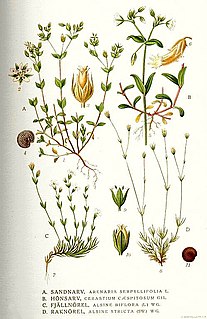
Minuartia stricta is a species of flowering plant in the family Caryophyllaceae known by the common names bog stitchwort, Teesdale sandwort and rock sandwort. It has a circumboreal distribution, occurring throughout much of the northernmost Northern Hemisphere from the lower Arctic into the alpine climates of mountainous areas in temperate Eurasia and North America. It grows in several types of habitat, including meadows, marshes, heath, beaches and bars, and arctic and alpine tundra.
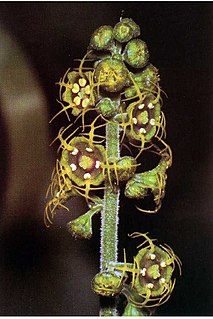
Mitella pentandra, or Pectiantia pentandra, is a species of flowering plant in the Saxifrage Family (Saxifragaceae), known by the common names fivestamen miterwort or five-point bishop's cap.
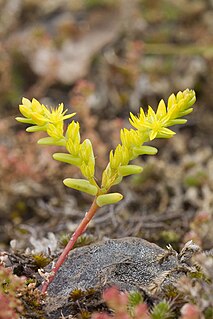
Sedella is a small genus of annual flowering plants in the family Crassulaceae. There are approximately 7 species, all native to California, United States, one with a distribution extending into Oregon. These are petite succulent plants growing a few centimeters tall and bearing tiny yellowish or brownish flowers. Mock stonecrop is a common name for these plants.
Sedella congdonii is a species of flowering plant in the family Crassulaceae known by the common name Congdon's mock stonecrop. It is endemic to California, where it can be found in the Sierra Nevada, often in rocky and moist habitat types. It is an annual herb growing just a few centimeters high. The oval succulent leaves are just a few millimeters long. The flowers occur in a cyme on thin branches. Each has yellow petals no more than 3 millimeters long.
Sedella leiocarpa is a rare species of flowering plant in the family Crassulaceae known by the common names Lake County mock stonecrop and Lake County stonecrop. It is endemic to Lake County, California, where it is known from only about ten occurrences in two locations. It is a resident of drying vernal pools and rocky clay flats, where it grows in colonies. It is a federally listed endangered species. This is an annual herb growing no more than four centimeters high. It is a tiny erect reddish or yellow succulent plant with sparse leaves each a few millimeters long. The flowers have yellow to reddish petals 3 or 4 millimeters long.

Sedella pumila is a species of flowering plant in the family Crassulaceae known by the common name Sierra mock stonecrop. It is native to California, where it grows in the North Coast Ranges and adjacent sections of the Central Valley to the Sierra Nevada foothills. It is a plant of vernal pools and similar habitat, growing in rocky and gravelly flats of serpentine soils, limestone, and soils of volcanic origin, often alongside mosses. This is an annual herb growing 2 to 17 centimeters high, in shades of green, yellow, and red. It has small knobby succulent leaves each a few millimeters long. The flowers atop the threadlike stems have fleshy sepals and yellowish petals a few millimeters in length. The flowers have a musty scent.

Plantago aristata is a species of plantain known by the common name bracted plantain or largebracted plantain. It is native to the eastern and central United States, and it can be found in other parts of North America as well as parts of Eurasia as an introduced species. It grows in many types of habitat, including disturbed areas, where it is a minor weed.
Stuckenia striata is a species of aquatic plant known by the common names broadleaf pondweedNevada pondweed and striped pondweed. It is native to the Americas, including the southwestern United States, northern Mexico, and parts of Central and South America. It grows in waterways such as rivers, canals, and shallow ponds, often in alkaline water. This is a perennial herb producing a long, thin, branching stem approaching 2 m in maximum length. The narrow, hairlike leaves are up to 10 cm (3.9 in) long and only a few millimeters wide. The inflorescence is a spike of flowers arranged in whorls and borne on a short peduncle.
Pseudobahia bahiifolia is a rare species of flowering plant in the family Asteraceae known by the common name Hartweg's golden sunburst.

Ranunculus uncinatus is a species of buttercup known by the common names woodland buttercup and little buttercup. It is native to western North America from Alaska to California to New Mexico, where it grows in wet, wooded habitat such as forest streambanks. It is a perennial herb producing a slender, erect stem which may exceed half a meter in maximum height. The lightly hairy lower leaves have blades deeply divided into three toothed lobes borne on long petioles. The upper leaves are smaller and divided into narrower lobes. The flower has four or five yellow petals a few millimeters long around a central receptacle and many stamens and pistils. The fruit is an achene borne in a spherical cluster.
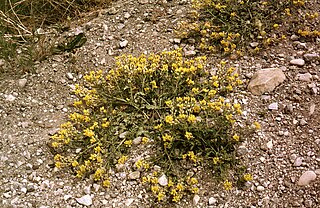
Rorippa columbiae is a species of flowering plant in the family Brassicaceae known by the common names Columbian yellowcress and Columbia yellow cress.
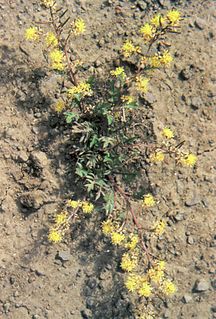
Rorippa sinuata is a species of flowering plant in the family Brassicaceae known by the common name spreading yellowcress. It is native to North America, including most all of the western and central United States, where it grows in many types of moist and wet habitat, such as lakeshores and riverbanks, meadows, and mudflats. It is a perennial herb producing spreading stems up to 40 or 50 centimeters long. It is densely hairy, the hairs rounded like sacs or vesicles. The leaves are up to 8 centimeters long and have blades are deeply toothed, lobed, or divided into smaller leaflets. The inflorescence is an elongated raceme occupying the top portion of the stem containing many tiny yellow flowers just a few millimeters long. The fruit is a curved silique which is variable in size and shape but generally contains many minute seeds.
Smelowskia ovalis is a species of flowering plant in the mustard family known by the common name alpine false candytuft. It is native to western North America from British Columbia to northern California, occurring mostly in the Cascade Range. It is a plant of alpine climates, growing in high mountain habitat such as talus and fellfields. It is clumpy in shape, producing several hairy stems growing erect to a maximum height around 18 centimeters. The densely hairy leaves are divided into several oval leaflets. The longest leaves are arranged around the base of the plant, and a few smaller ones occur farther up the stems. The inflorescence is a dense, spherical raceme of flowers that elongates as the fruits develop. The flowers have white or pink-tinged petals each a few millimeters long. The fruit is a short silique.

Stellaria longipes is a species of flowering plant in the family Caryophyllaceae known by the common names longstalk starwort and Goldie's starwort. It has a circumpolar distribution, occurring throughout the northernmost latitudes of the Northern Hemisphere. It is a perennial herb that grows in a wide variety of habitat types, including tundra and taiga and many areas farther south with subalpine and alpine climates. It is extremely variable in morphology, its form depending on both genetic makeup and environmental conditions. It has a widely varying number of chromosomes. In general, it is a rhizomatous perennial herb forming mats or clumps, or growing erect. The stems may be short and simple or with sprawling and highly branched. The linear to lance-shaped leaves are usually 1 to 4 centimeters long and are oppositely arranged in pairs. The inflorescence bears one or more flowers, each on a short pedicel. The flower has five pointed green sepals each a few millimeters long. There are five white petals each divided into two lobes, sometimes shallowly, but often so deeply there appear to be two petals. The plant is gynodioecious, with some flowers having functional male and female reproductive parts and others being only female.

Solidago missouriensis is a species of flowering plant in the family Asteraceae known by the common names Missouri goldenrod and prairie goldenrod. It is native to North America, where it is widespread across much of Canada, the United States, and northern Mexico. It grows from British Columbia east to Manitoba, south as far as Sonora, Coahuila, Texas, and Mississippi.

Hemizonella is a genus of North American plants in the tribe Madieae within the family Asteraceae.













